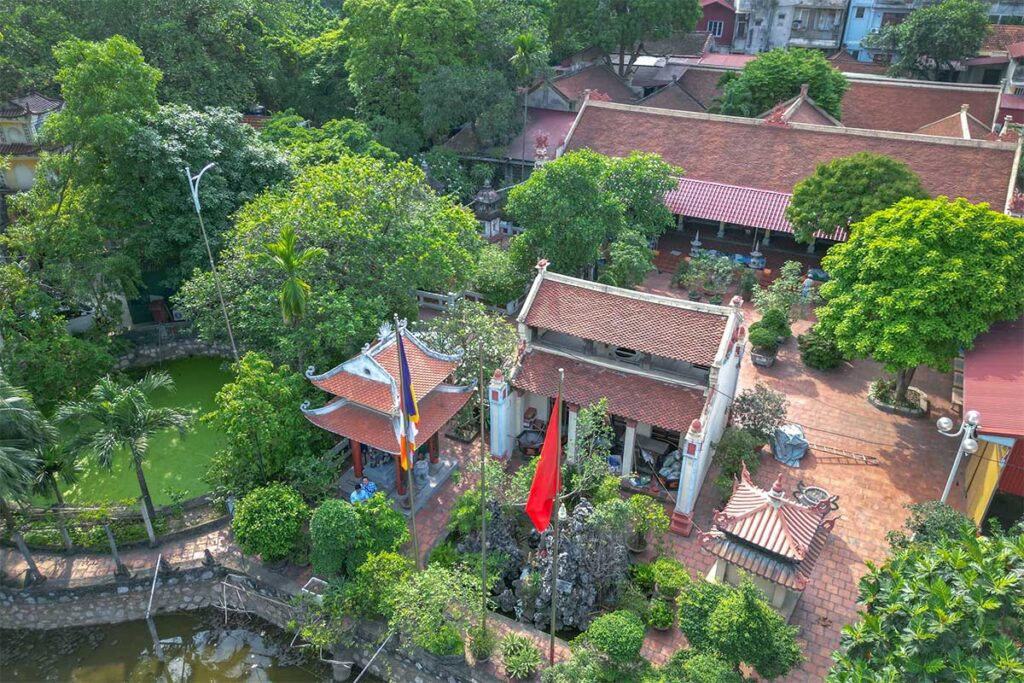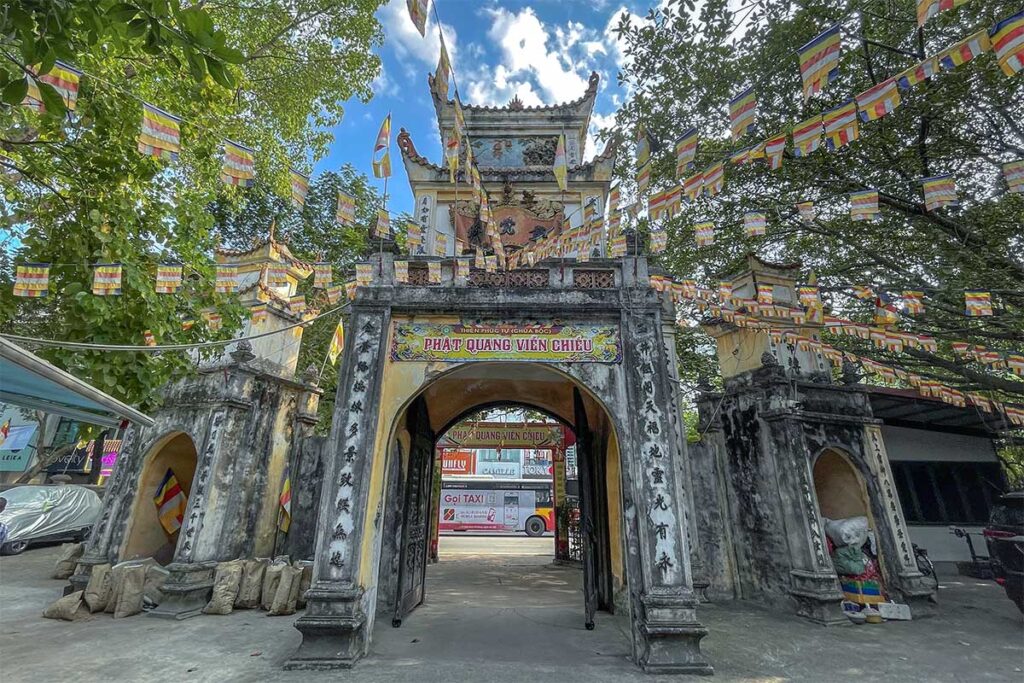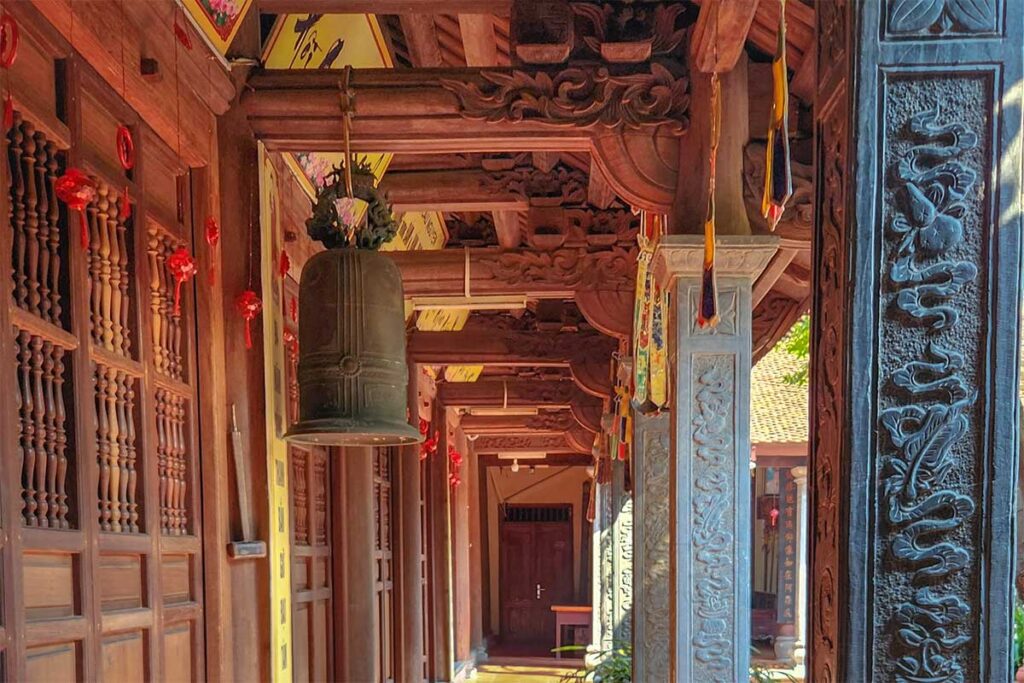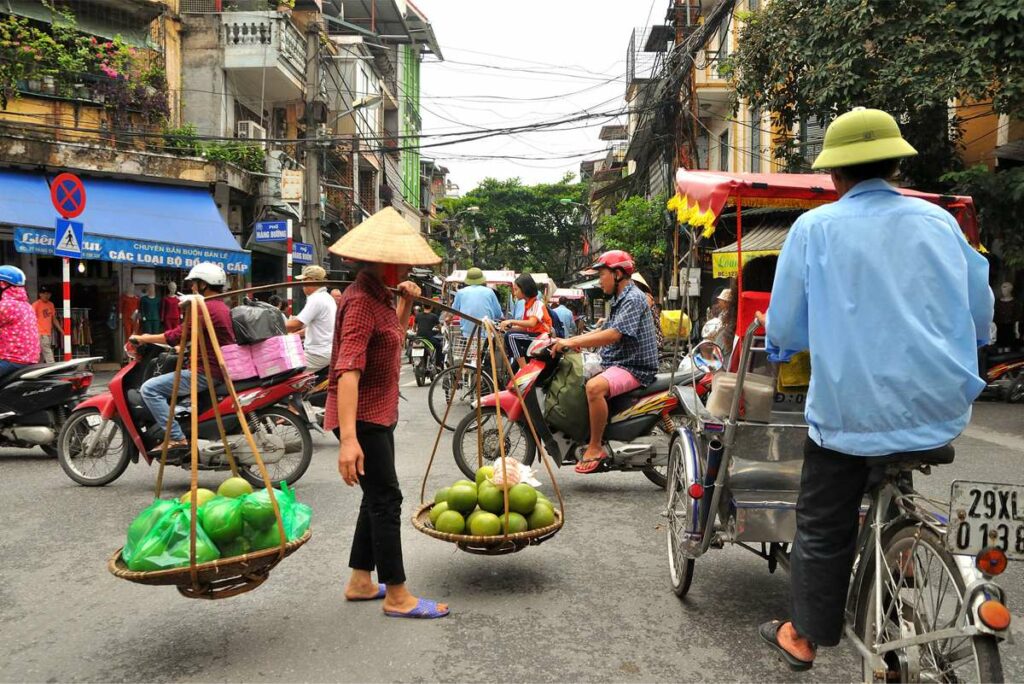What is Boc Pagoda like?
Boc Pagoda sits quietly behind the steady noise of Chua Boc Street — a busy road lined with shops, banks, and apartment blocks. Step through its gate, and you’ll immediately notice the shift: the scent of incense, a lotus-filled pond, and a courtyard where time seems to slow down.


It’s a modest but meaningful place. Locals come to light incense, pray for peace, or honor ancestors. Despite its size, the pagoda holds deep historical importance — especially for its ties to the Tay Son uprising and King Quang Trung’s 1789 victory. Boc Pagoda may not impress with grandeur, but it offers a calm, reflective space that stands apart from its chaotic urban surroundings.
History of Boc Pagoda
Boc Pagoda traces its origins to the late 17th century, during the reign of King Lê Hy Tông. Originally named Sung Phúc Tự or Thiên Phúc Tự, it served as a typical Buddhist temple for local worship.
That changed dramatically in 1789. During the Tây Sơn uprising, this area became the site of a key battle where King Quang Trung defeated the invading Qing army. The fighting left behind thousands of enemy casualties. The original pagoda was destroyed, and in the aftermath, a new structure was built on the same ground to honor both Buddhist tradition and the spirits of the fallen. This dual role gave rise to the name “Chùa Bộc” — with bộc meaning “to expose,” referring to the grim battlefield aftermath.
Since then, Boc Pagoda has become part temple, part war memorial. It commemorates not only the Tây Sơn victory but also acknowledges the loss of life from both sides. In 1964, the Vietnamese Ministry of Culture officially recognized it as a National Historical-Cultural Monument.
Who was Quang Trung?
Quang Trung, born Nguyễn Huệ, was one of Vietnam’s greatest military leaders and a central figure in the Tây Sơn uprising — a late 18th-century movement that overthrew corrupt feudal rule and resisted foreign invasions. In early 1789, during the famous Kỷ Dậu Victory, he led a surprise attack from the south and crushed a large Qing army stationed near Hanoi in just five days. The battle not only secured Vietnam’s independence but also made Quang Trung a national hero.
You can read more about him in our full guide to Quang Trung.
Highlights of visiting Boc Pagoda
While modest in scale, Boc Pagoda holds several features that reflect its unique blend of Buddhist tradition and military history:
1. Tam Quan Gate

The entrance gate is a striking two-tiered arch topped with sun and sword motifs — a rare design detail in Hanoi’s pagodas. The swords point upward, symbolizing strength and victory, while a large sign reads “Thiên Phúc Tự,” the temple’s historic name.
2. Statue Pond

Just past the gate is a small lotus-filled pond, believed to be where the Tây Sơn army’s war elephants were bathed after their victory. The water adds a peaceful, reflective touch to the otherwise urban setting.
3. Statue of Quang Trung

Inside the main hall, a seated statue known as Đức Ông is widely believed to represent King Quang Trung. He’s shown with a commanding yet humble presence — barefoot, in plain robes, with a crown and belt.
4. Tây Son Artifacts

The pagoda preserves several relics linked to the 1789 victory, including coin molds, ceremonial poems, a battle map of Đống Đa, and at least one inscribed stone stele recording its restoration history. These objects quietly reinforce the site’s historic weight.
5. Thanh Mieu Temple

At the rear of the pagoda grounds is a small temple built to honor the souls of fallen Qing soldiers — a rare example of post-war compassion in Vietnamese religious tradition.
6. Layout and Structure

The pagoda follows the traditional Đình (courtyard-style) layout, with a main hall, side buildings, a tower garden, and shaded walkways. While not elaborate, the structure feels purposeful and respectful.
Visiting information
Entrance Fee
There is no entrance fee to visit Boc Pagoda — as with most pagodas in Vietnam, entry is free. Donations are welcome but not expected.
Opening Times
The pagoda is open daily from 6:00 AM to 7:00 PM.
Location & Address
Address: 14 Chùa Bộc Street, Quang Trung Ward, Đống Đa District, Hanoi
It’s located in a busy local neighborhood about 5 km southwest of the Old Quarter.
How to get there
The easiest way to reach Boc Pagoda is by taxi or Grab. From the Old Quarter or French Quarter, the ride typically takes 15 to 25 minutes, depending on traffic. Expect more delays during rush hour.
Public buses are available but not ideal for most foreign visitors due to indirect routes and language barriers.
If you’d like to make more of the trip, you can combine the visit with stops like Thong Nhat Park, the Opera House, or parts of the French Quarter on your way — but you’ll need to either book a car with driver or order new rides at each stop.
Is it worth visiting?
Boc Pagoda is historically significant, especially for those interested in the Tây Sơn period or the legacy of King Quang Trung. It offers a peaceful atmosphere and a rare mix of Buddhist spirituality and military remembrance.
That said, it’s not one of Hanoi’s most visually impressive temples. The architecture is modest, and the surrounding area is mostly residential, with little else of interest nearby. For first-time visitors with limited time, it’s likely not a priority.
Boc Pagoda is best suited for repeat visitors, history buffs, or travelers with a deeper interest in Vietnam’s revolutionary past. If you want to include it in your day, consider hiring a private car to combine it with other stops like Thong Nhat Park, the French Quarter, or the Vietnam Military History Museum.
For more options, see our full guide to the best temples and pagodas in Hanoi.



